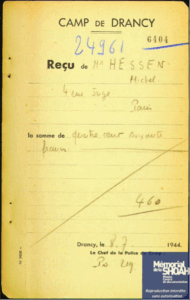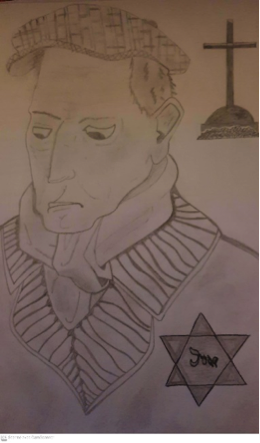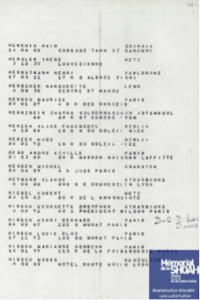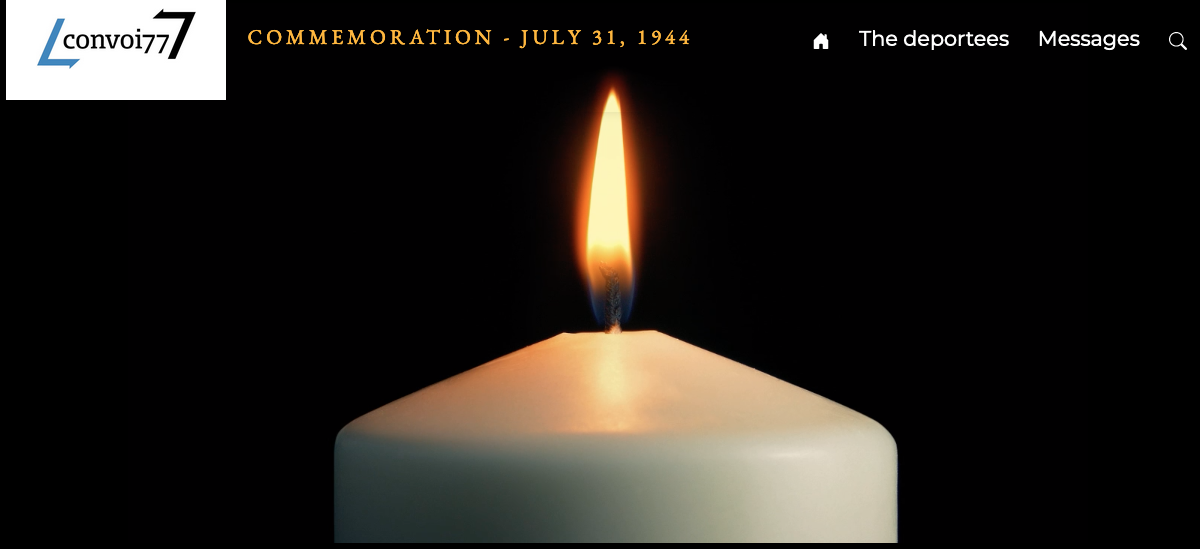Michel HESSEN (1887-1944)
Michel Hessen was born in 1887 in Saratov in western Russia. His parents, Samuel (b. 1868) and Tatiana Zinger (b. 1861), were still living there in 1918. All three were Russian citizens.
Michel had brown eyes, chestnut brown hair and stood 5’7” tall[1].
According to a record in the Paris Police Headquarters archives dated May 31, 1941, Michel was then “living in a marital relationship” with Berthe, or Brana Ita Tourianska[2], a Russian national born on October 19, 1888 in Odessa (now in Ukraine), who was a housewife and seamstress and who died in 1943. However, the fact that they were not legally married in no way means that they were not married in accordance with Jewish tradition. In fact, that was the only form of marriage accepted by the Jewish religion at the time. According to the same police report, the couple stopped living together in 1935.
Given that the records indicate that Brana was living in Belgium from 1901 onwards, it is possible that the couple met in Belgium. Michel had in fact spent some time in Belgium before relocating to France. According to census returns, he and his partner were living in Brussels in 1908, and the eldest of their five children, Annette, was born there.
An official French government file reveals that he declared himself as a foreign resident on December 20, 1909. On June 25, 1915, he was granted a residence permit, and on March 6, 1919 the Paris Police Headquarters issued him with a foreigner’s identity card.
A family well integrated into French society and naturalized as French citizens
The Hessen children went to the local state school. Two of Michel and Berthe’s daughters became stenographers, which means they must have at least passed their school-leaving certificate. The four children (the first son, Nicolas, was born in 1910 but died at home at the age of 21 months in 1912) were all granted French nationality at the same time as their father on December 13, 1927 (decree published in the French Official Gazette on December 25, number 38,537 x 27). According to a 1941 police memo, Michel was not required to do his national service due to his family circumstances.
Michel Hessen was not present when any of his children were born, and so it was not him who declared the births at the local town hall. He did, however, officially recognize them as his.
Annette, although she was born in Belgium on December 15, 1908, was educated in France. She declared she was a stenographer in the 1931 census. She died in the 12th district of Paris on January 29, 1995.
Marcel, who was born on December 2, 1914 in the 14th district of Paris, declared that the was an apprentice tailor in the 1931 census. He joined the 151st infantry regiment in October 1935, and was promoted from corporal to reserve sergeant in 1936. He was listed as an “indispensable family breadwinner” on October 29, 1936 and was discharged on October 1, 1937. He was nevertheless called up again on August 26, 1939.
Marcel was “killed by the enemy” during the “phony war”. It happened on the night of February 18-19, 1940, on the Alzine road, near Château-Rouge in the Moselle department of France. He was later declared to have “Died for France” and October 1949, his coffin was brought back to Paris, where he was buried in the Bagneux cemetery.
Simone (listed as Sarah in the French civil register) was born on August 27, 1916 in the 14th district of Paris. She too was a stenographer, and died in 2012 in the Eure department of France Olga, who was born on March 2 1922, got married in 1965 and went on to have two sons. She died in 1988 in Evreux, also in the Eure department.
Life in the 16th district of Paris
When he arrived in Paris, Michel Hessen did not set up home in the neighborhoods where Jewish migrants from Eastern Europe typically settled, such as the Marais, the République and the Bastille districts. Instead, he spent most of his thirty-four years in France in the 16th district, a fashionable area in the west of the capital that was home to a sizeable Russian community, together with Jews from the former Russian Empire.
In fact, he lived there for most of his time in France. When he first arrived in France, in 1909, he 11 rue de la Parcheminerie in the 5th district of Paris and then at 9 impasse Compoint in the 17th district until 1912, when he returned to Antwerp. However, when he moved back to Paris at the time of the German invasion in 1914[3], records show that he moved to the 16th district.
From 1921 to 1926, his son Marcel attended the boys’ school at 29 rue de Passy[4]. HIs daughters, Sarah and Olga, went to the nursery school at 29, rue de Passy; the former from 1921 to 1926, the second in 1925.
City census and police reports confirm that Marcel and his family lived on rue du Passy, firstly at number 11, then at 41, then at 24 and lastly at 42.
A possible separation
In 1935, Michel Hessen appears to have moved out of the family home and returned to Belgium until 1937. Marcel, his only son, then declared himself the sole provider for the family.
From 1937 until October 1939, Michel lived at 9 rue Boislevent, once again in the 16th district of Paris, where rented an apartment for 120 francs a month. As of October 28, 1939, he rented a “garnis”, meaning furnished room, at 32, rue de Passy.
A tailor caught up in the recession
Michel Hessen worked as a tailor, specializing in womenswear. In 1927, when he applied to be naturalized as a French citizen, he declared that he was earning 40,000 francs a year.
At the start of the First World War, he was a cloth cutter at a municipal military underwear workshop at 8 rue Lecourbe, then, in 1917, he worked as a tailor for Emma Franck (of les Galeries parisiennes) at 50 rue de Passy (until 1931?), and for Marie Lefranc, a lingerie maker at 75 rue des Batignolles, both of whom testified to his good character to help him acquire French nationality.
In the 1930s, when the Great Depression hit Europe, Michel, like millions of other people, found himself out of work. In 1937, he registered for unemployment benefit at the town hall in the 16th district of Paris. He was still claiming benefits in 1939, but by 1941, he was working for Maison Thiébault at 42 rue de Berry in the 8th district.
Despite the French government’s anti-Semitic legislation, which limited employment opportunities for Jews, Michel Hessen continued working, but at home (there was a dressmaking workshop at 42 rue de Passy in 1941, run by Eve Lyne). A police report dated July 1, 1941, states “he is registered for the unemployment scheme and receiving a daily allowance of 12 francs[5]”.
Arrest and deportation
A police report dated May 1941 states that Michel Hessen and his three daughters had “complied with the German order of October 13, 1940”. In other words, they had registered themselves as Jews.
In July 1941, another police report stressed that “the findings are satisfactory as regards (his) conduct and (his) good character”, went on to say “he has never attracted any political or national attention” and that he had no criminal record.
Such information was gathered in order to decide whether or not people should be “de-naturalized”, i.e. have their French citizenship rescinded. This was in accordance with a French government law passed on July 22, 1940 which enabled the authorities to review the status of foreigners who had previously been naturalized.
However, by 1944, he was nothing more than just another Jew to be hunted down.
On July 7, 1944, following a tip-off, the French police arrested Michel Hessen in a hotel at 4 rue Juge in the 15th district. The reason given was that he was “not wearing the star”. He arrived at the Paris Police Headquarters depot at 11.30am on July 8. Later the same day, at 4pm, he was taken to Drancy camp. Located the north of Paris, Drancy was a transit camp in which Jews were interned prior to being deported.
When he arrived at Drancy, Michel was assigned the number 24,961 and was required to declare and to “deposit” all his money and valuables with the camp authorities. HIs search receipt (see image below) reveals that he handed over the 460 francs he had on him.
On July 31, 1944, after spending around three weeks in Drancy, which was run by the Nazi SS officer Aloïs Brunner, Michel was deported to Auschwitz on Convoy 77.
He was no doubt sent to the gas chambers and murdered soon after the convoy arrived in Auschwitz, on the night of August 3-4, 1944. In 1993, an announcement in the French Official Gazette corrected his date and place of death. Michel Hessen was officially deemed to have died on August 5, 1944 in Auschwitz, (rather than in Drancy, which was sometimes used as the place of death in order to speed up administrative procedures).
Annette’s extensive post-war efforts
After the war, Michel’s eldest daughter, Annette, applied to have him granted the status of “political deportee”. Her sisters Olga and Sarah, who lived together in the Eure department, authorized her to complete all the necessary formalities.
In the file she submitted, Annette stated that she had received a letter from her father from Drancy camp, which is quite remarkable given that the commander of the camp, Aloïs Brunner, had forbidden all communications with the outside world and forbidden prisoners from receiving parcels ever since he took over in June 1943. Sending a letter was therefore not only a great risk for the prisoner, but also for the person to whom it was addressed, since it might have given them away to the Nazis. Another record, dated July 1962, refers to a certificate given to Annette, who was then living at 42, rue de Passy, the family’s pre-war address. Might Annette have continued to live there during the Occupation?
Annette stated that she did not know if it was the French police who arrested her father, but that he had been arrested as a result of a tip-off. She gave the name of the person who ran the hotel where Michel had been “living” as a witness, and was even able to give their address at the time, February 28, 1962.
The application was approved during a session held on September 25, 1963. Michel was granted the status of “political deportee”. This replaced the controversial term “racial deportee”, which had still been used in a record as recently as March 1962. On January 16, 1964, Annette received a check for 120 francs from the French State treasury. That was all her father’s life was worth.
For families, putting together a claim was both wearisome and costly. Annette, who states that she had a heart condition, pointed this out in a letter dated February 10, 1963. “I had a whole pile of paperwork to gather together and have photocopied,” she wrote, followed by “I do not go out to work and what with the photocopies and the witnesses I had to inconvenience, I had to deal with and pay for all that”. Might the paperwork have dragged on for such a long time due to financial constraints??
In 1963, in an exchange of official correspondence, it was noted that the “departments have not been able to determine what exactly happened to Mr. Hessen Michel, who was deported on July 31, 1944 to Auschwitz, Poland”.
In February 1965, Annette once again asked for Michel to be officially declared dead by a court of law.
Lastly, in 1972, the Ministry of Veterans and Victims of War asked the mayor of the 15th district of Paris to have words “Died for France” added to Michel Hessen’s death certificate. All people deported from France were entitled to this. Michel was thus, at last, honored in the same way as his son Marcel, who died at the front during a German ambush many years earlier.
Source: The convoy 77 deportation list
The Wall of Names at the Shoah Memorial in Paris. Michel Hessen’s name is listed on slab n° 18, column n° 6, row n° 3

Source: Michel’s receipt, from the Drancy search log
SOURCES:
Naturalization decree, no 38537 X 27
https://www.siv.archives-nationales.culture.gouv.fr Central National Security file, also known as the “Moscow fund” (France)
Documents provided by the Convoi 77 team: Files from the Victims of Contemporary Conflicts Archives Division of the French Ministry of Defense Historical Service, in Caen, in Normandy: 21P 258 208 and 21 P 571 462. Foreigners’ file and depot certificate from the Paris Police Headquarters archives: APP the 95, foreigners’ files and APP CC2-8.
https://ressources.memorialdelashoah.org
Shoah Memorial, Paris:
- Registration record 1940: FRAN107_F_9_5646_050699_L
- Registration record 1941: FRAN107_F_9_5614_011568_L
- Drancy camp internment record: FRAN107_F_9_5700_157192_L
- Drancy camp transfer log: FRAN107_F_9_5788_0013_L
Paris archives: viewed during a workshop held in December 2024
- D2M8 431: 1931 census, 42 rue de Passy, 75016, quartier Muette
- D2M8: 1936 census, 42 rue de Passy, 75016, quartier Muette
- 5N 236: Nicolas Hessen’s birth certificate, 75005, 1910 and death certificate 75005, 1912
- 14N 515: Marcel Hessen’s birth certificate, 75014, 1914
- D4R1 3351: Michel Hessen’s service record, 1934
- 14N 535: Sarah Hessen’s birth certificate, 75014, 1916
- 15D 485: Michel Hessen’s death certificate
- 16D 167: Brana Ita Tourianska’s death certificate
- 6N 301-2: Olga Hessen’s birth certificate, 75005, 1922
- 3005W 1 nursery school register, 29 rue de Passy (1907-1960)
- 3005W 3: nursery school register, 29 rue de Passy (1916-1948)
- 3013W 6: boys’ school register, 29 rue de Passy (1916-1922)
French Official Gazette, June 10, 1993 : correction of the date and place of death of Michel Hessen, addition of the words « died during deportation » on his death certificate
Robert Pick’s, Du village de Passy à la rue de Passy, (From the village of Passy to the rue de Passy) published by L’Harmattan in 2017.
Notes & references
[1] Description of a request for papers submitted to the Police Headquarters, in APP Ia-95 Michel Hessen.
[2] The French National Archives holds a file on her from the National Security Service, known as the “Moscow funds”. File number: 199940477 / 128, file 12054 Tourianska Brana Yta. There is also a file on her from the Immigration Police in Antwerp, Belgium, which documents her presence there between 1901 and 1915.
[3] Dossier APP Ia-95, Michel Hessen, information sheet from the Foreigners Department dated December 31, 1918.
[4] On one of the school reports, it says « a sleepy child, not very intelligent, nice personality, reads and writes reasonably well”. The report is held in the Paris Archives, reference 3013 W 6.
[5] APP Ia-95, Michel Hessen.


 Français
Français Polski
Polski













